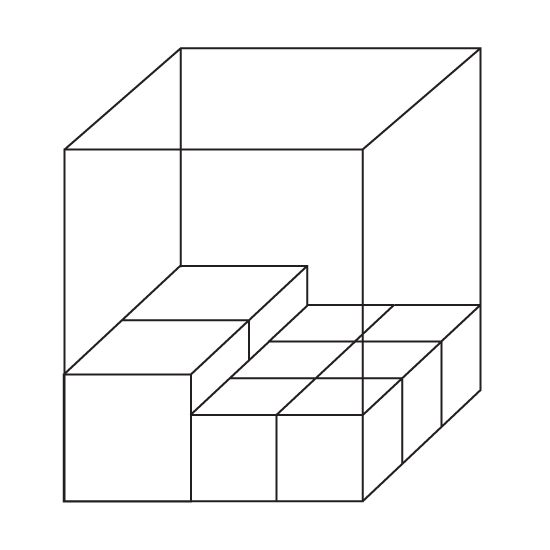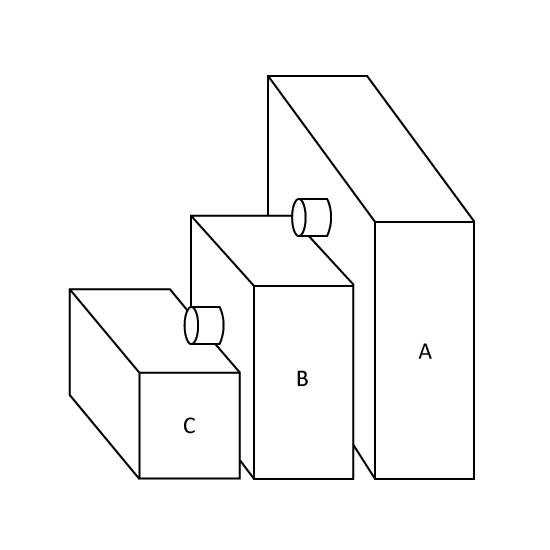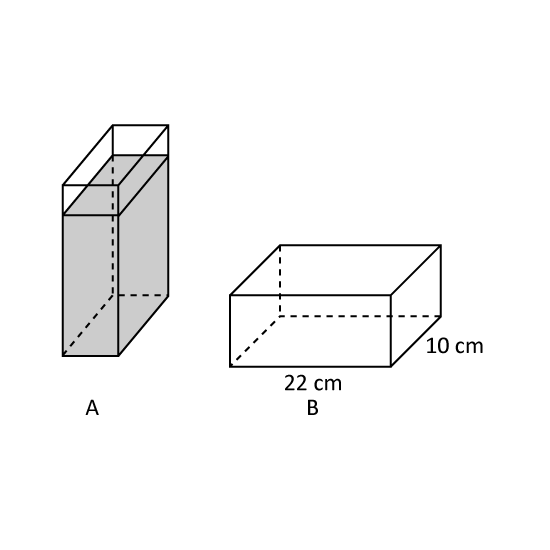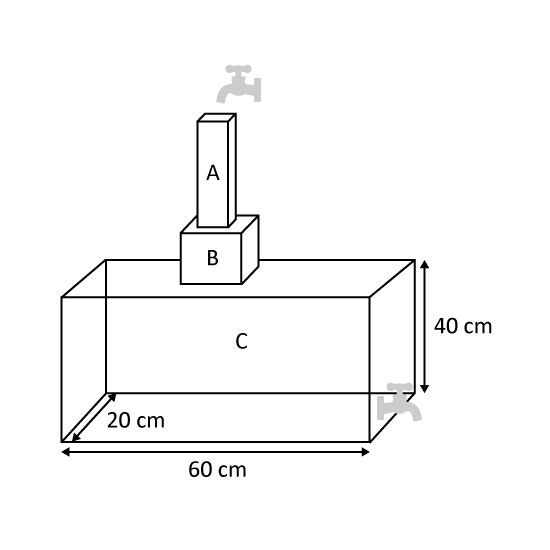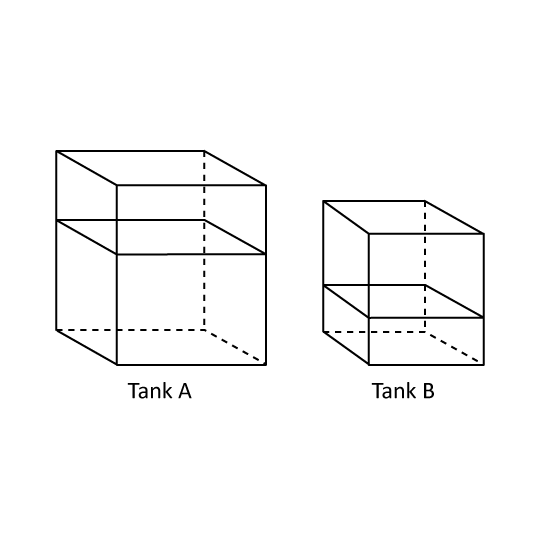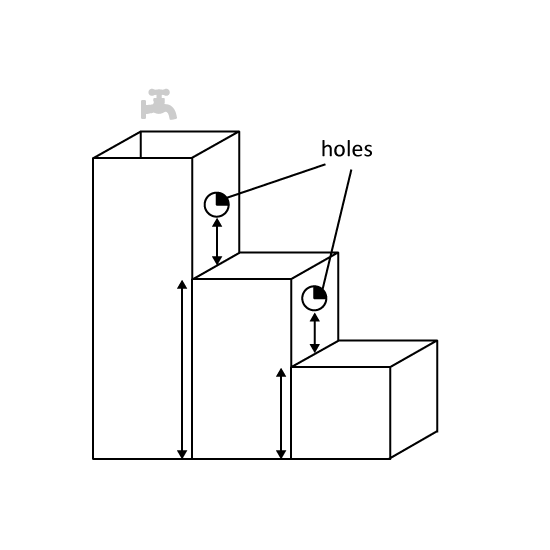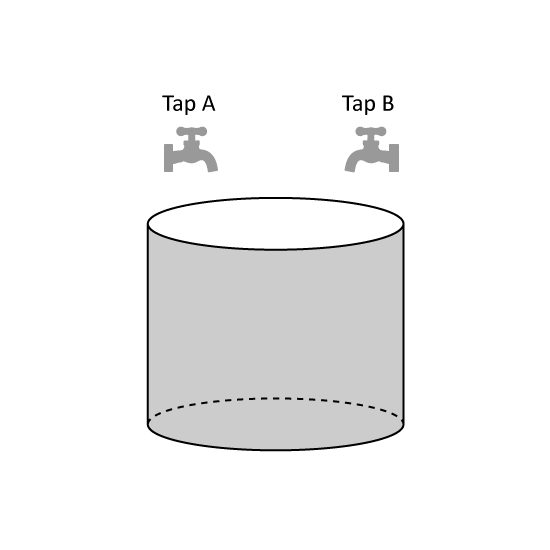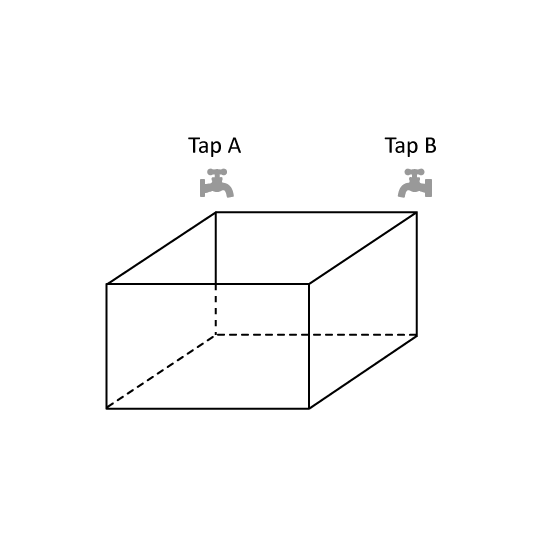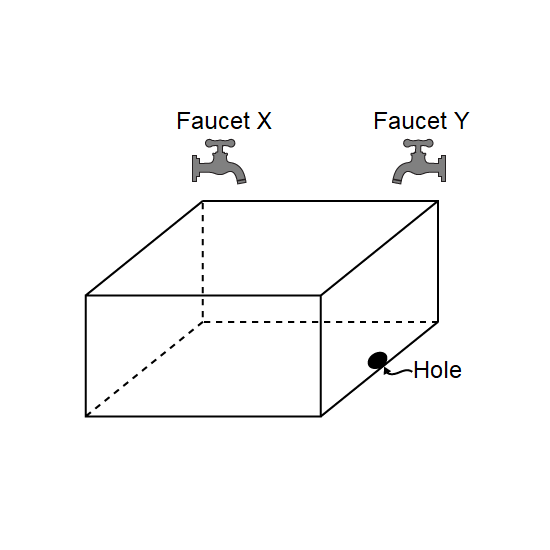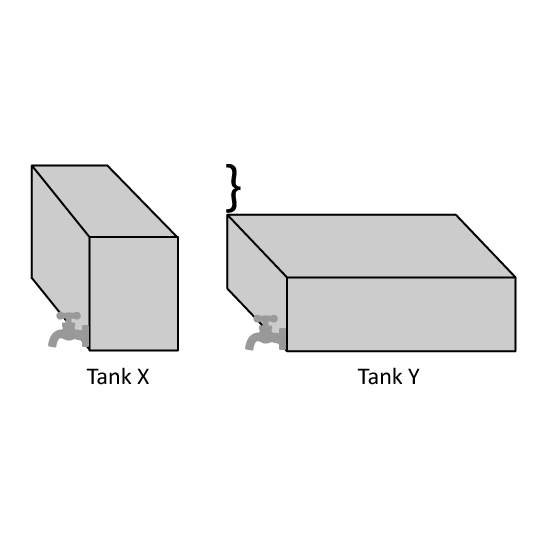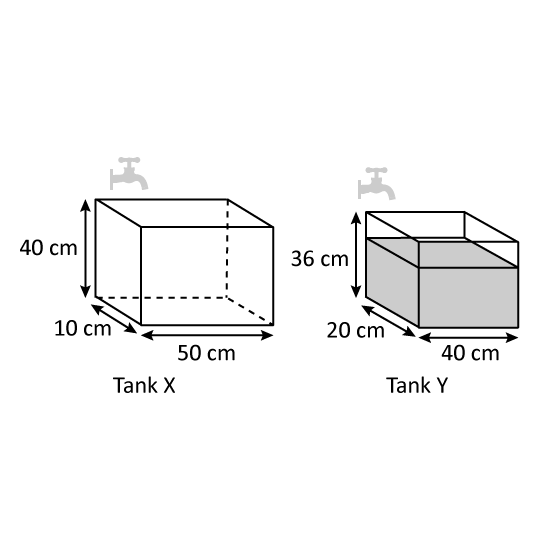Level 3 PSLE
David has 8 large cubes and some small cubes. He placed them in a rectangular tank. The tank was filled to the brim exactly. The diagram shows the first layer of cubes.
- How many small cubes does David have?
- The volume of the tank is 504 cm3. If the large cubes took up 37 of the tank, What is the length of the edge of one small cube?
Level 3 PSLE
David has 8 large cubes and some small cubes. He placed them in a rectangular tank. The tank was filled to the brim exactly. The diagram shows the first layer of cubes.
- How many small cubes does David have?
- The volume of the tank is 504 cm3. If the large cubes took up 37 of the tank, What is the length of the edge of one small cube?
Image in this question is not available.
Level 3
A container holds some water up to a height of 71 cm. When 6 identical plastic balls are put into the container, the water level rises by 18 cm. One plastic ball is then removed from the tank, replaced by one metallic ball. The water level increases to 136 cm.
- Find the ratio of the volume of 1 plastic ball to 1 metallic ball.
- If the base area of the container is 150 cm2, find the difference in the volume between the metallic ball and the plastic ball. Give the answer in cm3.
4 m
Image in this question is not available.
Level 3
The total volume of water in Watering Can A, Watering Can B and Watering Can C was 205 mℓ. I poured out half the volume of water from Watering Can A, doubled the amount of water in Watering Can B and added 55 mℓ of water into Watering Can C. The ratio of the volume of water in Watering Can A to Watering Can B to Watering Can C is now 5 : 4 : 8. Find the total volume of water in the three watering cans now.
4 m
Image in this question is not available.
Level 3
In the diagram not drawn to scale, Tank J and Tank K each has a button that, when pressed, will cause the water to flow out if the water level is higher than the hole. Tank J measures 134 cm by 42 cm by 137 cm. Tank K measures 55 cm by 21 cm by 68 cm. Tank L is 69 cm by 20 cm by 26 cm. Both holes are located at a height of 14 cm from the top of their respective containers. When Tank J is completely filled with water and both buttons are pressed, what will be the final water level in Tank L?
Level 3
In the diagram not drawn to scale, Tank J and Tank K each has a button that, when pressed, will cause the water to flow out if the water level is higher than the hole. Tank J measures 134 cm by 42 cm by 137 cm. Tank K measures 55 cm by 21 cm by 68 cm. Tank L is 69 cm by 20 cm by 26 cm. Both holes are located at a height of 14 cm from the top of their respective containers. When Tank J is completely filled with water and both buttons are pressed, what will be the final water level in Tank L?
Image in this question is not available.
Level 3 PSLE
A and B are two rectangular containers. The base area of A is 30 cm
2 and the base of B has dimensions as shown. A contained 750 cm
3 of water and B was empty.
- What was the height of the water level in A?
- Ben poured some water from A into B without spilling. After that, the height of the water level of A was the same as that of B. How much water did Ben pour into B?
Level 3 PSLE
A and B are two rectangular containers. The base area of A is 30 cm
2 and the base of B has dimensions as shown. A contained 750 cm
3 of water and B was empty.
- What was the height of the water level in A?
- Ben poured some water from A into B without spilling. After that, the height of the water level of A was the same as that of B. How much water did Ben pour into B?
Image in this question is not available.
Level 3
Tank A measuring 40 cm by 17 cm by 146 cm is filled with water. Tank B is with a square base of side 68 cm is empty. Water is poured from Tank A into Tank B until the water level in Tank B is twice the height of the water in Tank A. What is the height of the water level in Tank B?
Level 3
Tank A measuring 40 cm by 17 cm by 146 cm is filled with water. Tank B is with a square base of side 68 cm is empty. Water is poured from Tank A into Tank B until the water level in Tank B is twice the height of the water in Tank A. What is the height of the water level in Tank B?
Image in this question is not available.
Level 3
The figure is not drawn to scale. Tank A and Tank B have base areas of 1500 cm
2 and 1000 cm
2 respectively. Water was poured into an empty rectangular Tank A until it reached a height of 20 cm. Some of the water was then poured from Tank A into Tank B which contained 1.5 ℓ of water until the height of the water in both tanks were the same.
- Find the new height of the water in Tank A.
- How many litres of water were poured into Tank B?
Level 3
The figure is not drawn to scale. Tank A and Tank B have base areas of 1500 cm
2 and 1000 cm
2 respectively. Water was poured into an empty rectangular Tank A until it reached a height of 20 cm. Some of the water was then poured from Tank A into Tank B which contained 1.5 ℓ of water until the height of the water in both tanks were the same.
- Find the new height of the water in Tank A.
- How many litres of water were poured into Tank B?
Image in this question is not available.
Level 3
A car uses 9 litres of petrol for every 50 km it travels at an average driving speed is 80 km/h. It uses 6 litres of petrol for every 70 km it travels when it average driving speed is 60 km/h. How much petrol will the car consume use for a journey which lasts 12 h if it travels at 80 km/h for 5 h and 60 km/h for the rest of the journey?
4 m
Image in this question is not available.
Level 3
A pool measuring 50 m x 25 m x 2 m was completely filled with water. The water was draining out of the tank at a constant rate and became completely empty after 25 minutes.
- What fraction of the pool was filled with water at the end of 24 minutes? Express the answer in the simplest form.
- How many litres of water was drained out of the pool at the end of 10 minutes?
4 m
Image in this question is not available.
Level 3
A rectangular container 100 cm by 50 cm by 45 cm was 20% filled with water. A tap was turned on to fill it up with water at a rate of 9 ℓ /min. Every 30 seconds after the tap was turned on, an iron ball of volume 500 cm3 was added to the container. How many iron balls of the same volume would there be in the container when the container is 100% filled with water?
4 m
Image in this question is not available.
Level 3
This figure is not drawn to scale. A rectangular glass tank 72 cm by 50 cm by 35 cm has 2 compartments, X and Y, with a water height of 30 cm in X and 15 cm in Y. A hole in the slider caused water to leak from X to Y. It was found that the water level in both compartments became the same after some time.
- What is the height of water in the tank now?
- It took 112 h for the water in both compartments to reach the same level. Assuming that water leaked at a constant rate, how much water flowed from X to Y in 1 minute? Express the answer to 1 decimal place in cm³.
Level 3
This figure is not drawn to scale. A rectangular glass tank 72 cm by 50 cm by 35 cm has 2 compartments, X and Y, with a water height of 30 cm in X and 15 cm in Y. A hole in the slider caused water to leak from X to Y. It was found that the water level in both compartments became the same after some time.
- What is the height of water in the tank now?
- It took 112 h for the water in both compartments to reach the same level. Assuming that water leaked at a constant rate, how much water flowed from X to Y in 1 minute? Express the answer to 1 decimal place in cm³.
Image in this question is not available.
Level 3
Nick placed three empty containers side by side. The smallest container has a crack at the bottom of its side and the base area of each container is 18 cm2. After he turned on the faucet for 68 minutes, the height of the water in the smallest container became 8 cm although 0.8 mℓ of water is leaking out of the crack per minute. Find the rate of flow of water from the faucet. Give the answer in mℓ/min.
Level 3
Nick placed three empty containers side by side. The smallest container has a crack at the bottom of its side and the base area of each container is 18 cm2. After he turned on the faucet for 68 minutes, the height of the water in the smallest container became 8 cm although 0.8 mℓ of water is leaking out of the crack per minute. Find the rate of flow of water from the faucet. Give the answer in mℓ/min.
Image in this question is not available.
Level 3
When both printers U and V are used, a collection of books can be printed in 3 hours. While printing, Printer U broke down. As a result, it took 1
13 hours to complete printing. If it would take Printer V 4 hours to print the collection alone,
- how long would it take to print the collection of books using only Printer U? Express your answer in hours.
- how long was Printer U used before it broke down? Express your answer in hours.
4 m
Image in this question is not available.
Level 3 PSLE
The figure shows an empty tank placed below two taps A and B. It takes 10 min to fill the tank with Tap A alone and 2 min Tap B alone.
- With only Tap A turned on, what fraction of the tank will be filled in 1 minute?
- Starting with an empty tank, how long does it take for both taps together to fill 14 of the tank? Give your answer in seconds.
Level 3 PSLE
The figure shows an empty tank placed below two taps A and B. It takes 10 min to fill the tank with Tap A alone and 2 min Tap B alone.
- With only Tap A turned on, what fraction of the tank will be filled in 1 minute?
- Starting with an empty tank, how long does it take for both taps together to fill 14 of the tank? Give your answer in seconds.
Image in this question is not available.
Level 3 PSLE
The figure shows Tap A, Tap B and an empty tank with a capacity of 54.2 litres. Water flows Tap A at 3.1 litres per minute and from Tap B at 2.9 litres per minute. Tap A was turned on first. Tap B was turned on 2 minutes later. The taps were turned off at the same time when the tank was completely filled without overflowing. How much water flowed from Tap A?
Level 3 PSLE
The figure shows Tap A, Tap B and an empty tank with a capacity of 54.2 litres. Water flows Tap A at 3.1 litres per minute and from Tap B at 2.9 litres per minute. Tap A was turned on first. Tap B was turned on 2 minutes later. The taps were turned off at the same time when the tank was completely filled without overflowing. How much water flowed from Tap A?
Image in this question is not available.
Level 3
A tank is to be filled to the brim. Tap A takes 20 minutes to fill the tank while Tap B takes 15 minutes to fill it. How long will it take to completely fill the tank with water if both the taps are turned on at the same time? Leave the answer in minutes and round off to 1 decimal place.
4 m
Image in this question is not available.
Level 3
Faucet X can fill a container completely in 5 hours while Faucet Y takes 1 hour more to fill the same container completely. There is a hole at the bottom of the container which can empty the full container in 10 hours. How long does it take for the container to be completely filled if both faucets are turned on? Express the answer in mixed number of hours.
Level 3
Faucet X can fill a container completely in 5 hours while Faucet Y takes 1 hour more to fill the same container completely. There is a hole at the bottom of the container which can empty the full container in 10 hours. How long does it take for the container to be completely filled if both faucets are turned on? Express the answer in mixed number of hours.
Image in this question is not available.
Level 3
The figure shows 2 completely filled tanks being emptied of the water from 2 different taps. The difference in height between Tank X and Tank Y is 5 cm. The taps at Tank X and Tank Y were turned on at 0700 and 0830. respectively, until both were completely empty. At 1100, the water level in both tanks was the same. At 1230, Tank Y was completely empty and Tank X was only completely empty at 1300. If the rate of the flow of water from each tap was constant throughout, what was the height of Tank Y?
Level 3
The figure shows 2 completely filled tanks being emptied of the water from 2 different taps. The difference in height between Tank X and Tank Y is 5 cm. The taps at Tank X and Tank Y were turned on at 0700 and 0830. respectively, until both were completely empty. At 1100, the water level in both tanks was the same. At 1230, Tank Y was completely empty and Tank X was only completely empty at 1300. If the rate of the flow of water from each tap was constant throughout, what was the height of Tank Y?
Image in this question is not available.
Level 3
It takes Faucet X 15 minutes to fill a tank measuring 14 cm by 8 cm by 12 cm completely while it takes Faucet Y only 10 minutes. How long will it take to completely fill the tank with water if both faucets are turned on at the same time and 3 cubic cubes of edges 3 cm, filled with water, are poured into the tank? Leave the answer in minutes and round off to 2 decimal places.
4 m
Image in this question is not available.
Level 3 PSLE
Two rectangular tanks are shown. At first, Tank X was empty and one quarter of Tank Y was filled with water. Both taps were turned on at the same time and water from both taps flowed at the same rate of 1.6 litres per minute. How much time will it take for the height of the water to be the same in both tanks? (1 litre = 1000 cm3 )
Level 3 PSLE
Two rectangular tanks are shown. At first, Tank X was empty and one quarter of Tank Y was filled with water. Both taps were turned on at the same time and water from both taps flowed at the same rate of 1.6 litres per minute. How much time will it take for the height of the water to be the same in both tanks? (1 litre = 1000 cm3 )
Image in this question is not available.
